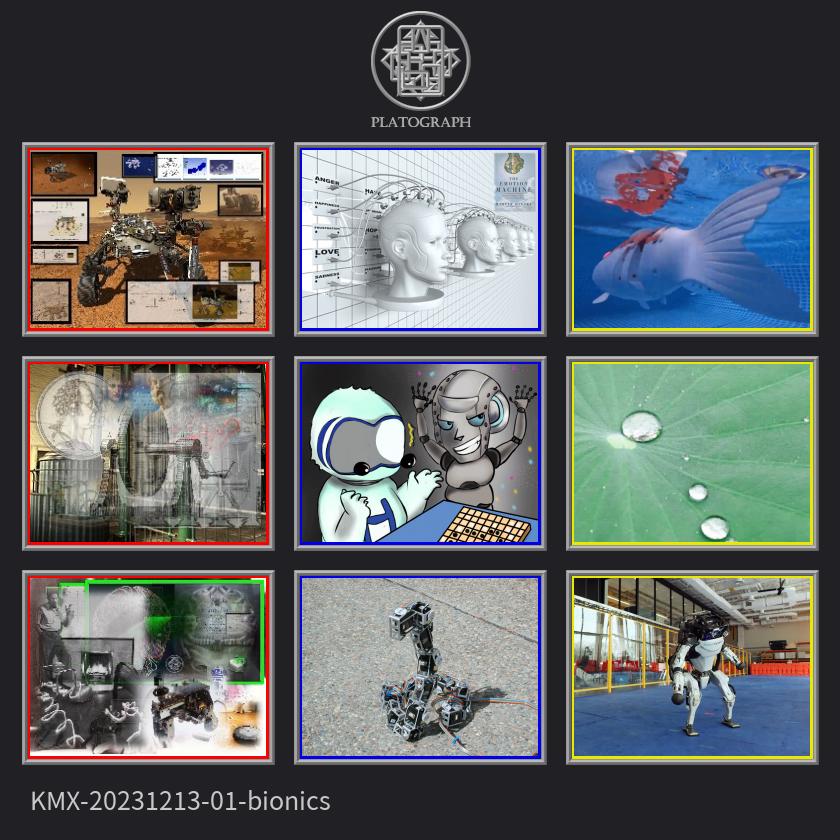
The above documents discuss various topics related to robotics, mechanics, artificial intelligence, and biomimicry. Here is a summarized overview:
Document D1 focuses on the steering system of a versatile vehicle called VwV. It discusses the systematic design of remote/automatic steering for a robot-rover, including components such as motors, batteries, gears, gearboxes, screws, joints, rockers, lever systems, suspensions, wheels, tires, pumps, compressors, and drillers. The document also mentions the integration of kinematic and thermodynamic mechanisms using artificial intelligence (AI) generated frames.
Document D2 introduces the concept of a cybernetic tortoise named Machina Speculatrix, which is a cognition robot. It explains that William G. Walter based this invention on the cybernetic theory derived from his alpha-brainwave research in neuroscience. The tortoise robot utilizes pure analog circuitry to simulate brain processes, as opposed to the digital intelligence of Turing/Von-Neumann.
Document D3 discusses the role of machinery and mechanics in kinematics and kinetics. It explores concepts such as force, leverage, torque, stress-tensor, elasticity, kinetic energy of rigid and elastic bodies, translation, rotation, work, heat, mass distribution and density, deformation, crack analysis, and material structure. The document also mentions the application of mechanical geometry in automation, including levers, gears, transmissions, engines, and robots.
Other documents mentioned include K1, which mentions a high adaptive reptile, K2 talks about Ke Jie being defeated by AlphaGo (an AI), and K3 discusses the relationship between emotion models and artificial intelligence. Additionally, some documents are related to specific YouTube videos or articles about topics like robotics mimicking human movements, superhydrophobicity inspired by the lotus leaf, and the NTUT AIFish Robot Fish.
Overall, these documents cover a range of topics related to robotics, mechanics, AI, and biomimicry, providing insights into various aspects of these fields.
近年来,人们对机器人和人工智能的研究与应用越来越广泛。其中,对多功能车辆VwV的操控系统进行了系统设计,包括遥控/自动转向功能的设计。该系统使用了电机/电池、齿轮/齿箱传动、螺旋/关节、摇杆-博吉/杠杆、悬架、车轮/轮胎、泵/压缩机、打孔机等运动学/热力学机制,通过人工智能生成框架与有限元分析相结合。此外,还有基于神经科学的alpha脑波研究理论的走步机器人(Machina Speculatrix),该理论强调纯模拟脑部处理过程的模拟电路(BEAM机器人),与图灵/冯·诺伊曼的数字智能相对应。机械与运动学/动力学的关系涉及到力/杠杆/力矩/应力张量/弹性等概念,包括刚体/弹性体的动能、平移/旋转、功/热量、质心/分布/密度、变形和裂纹、材料结构等知识,并结合机械几何、杠杆、齿轮、传动、发动机和机器人等自动化技术进行应用。其中,高适应性爬行动物、柯洁被AlphaGo困扰的情况、情感模型与人工智能之间的关系、YouTube视频《Do You Love Me?》、莲叶的超疏水性以及仿生学在机器鱼方面的应用都是这些文献中的研究重点。从这些文献中可以看出,机器人的设计和应用受到了自然界的启发,人们在模拟人类行为和提高人工智能的能力方面取得了一定的进展。
這次主題從北科的仿生魚出發,探討仿生學的技術。從右上角的圖譜可以看到,北科仿生魚的相關報導和介紹。
從古至今,人類有很多發明都是模仿動物的身體、習性去做開發、研究,最後到應用。以 DOMINO 來看,我們挑選了一天關於機械上可能會需要使用到的技術;KM 的部分則是一天現今的實際研究和應用,像是下圍棋的 AIphaGO 以及模仿蛇的爬行類機器人;最後的 HM 我們找到了一本關於仿生學的書《Biomimetics Learning from Nature》以及先前老師有給我們看過的模仿人類活動的機器人。
這些資料都讓我們能夠更加深入地了解仿生學,現在流行的 AI 技術也是因為他越來越像人類,可以模仿人生做很多工作,但我不認為仿生學的目的是為了取代,之所以有了飛機之後還有鳥在飛、有了蛙鞋之後還有青蛙,就是因為他們都有無可取代的東西,而人類也是同理。
